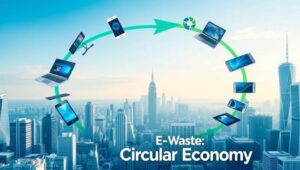Reducing E-Waste: Circular Economy for Electronics (2026 Initiatives)
Electronic waste, or e-waste, is a growing global concern. Discarded computers, smartphones, and other electronic devices contain hazardous materials that can harm the environment and human health if not properly managed. In response, the concept of a circular economy is gaining traction as a sustainable solution for electronics. This article explores the principles of a circular economy and examines initiatives planned for 2026 aimed at reducing e-waste.
What is a Circular Economy?
A circular economy is an economic system focused on minimizing waste and maximizing the use of resources. Unlike the traditional linear economy (take-make-dispose), a circular economy aims to keep products and materials in use for as long as possible. This is achieved through various strategies, including:
- Product Design: Designing products for durability, repairability, and recyclability.
- Reuse and Repair: Extending the lifespan of products through reuse, repair, and refurbishment.
- Recycling: Recovering valuable materials from end-of-life products.
- Closed-Loop Systems: Ensuring that materials are recycled and reused to create new products.
E-Waste: A Growing Problem
The rapid pace of technological advancement has led to a surge in e-waste. According to the United Nations, the world generates an estimated 50 million tons of e-waste annually, and this number is expected to continue rising. Much of this e-waste ends up in landfills, where it can leach harmful substances into the soil and water. Informal recycling practices in developing countries also pose significant health and environmental risks.
2026 Initiatives for a Circular Economy in Electronics
Several initiatives are planned for 2026 to promote a circular economy for electronics:
- Extended Producer Responsibility (EPR) Schemes: Many countries are implementing or strengthening EPR schemes, which hold manufacturers responsible for the end-of-life management of their products. In 2026, we can expect to see more robust enforcement of EPR regulations, requiring companies to take back and recycle their electronic products.
- Design for Circularity Standards: Efforts are underway to develop international standards for designing electronics for circularity. These standards will encourage manufacturers to create products that are easier to repair, upgrade, and recycle. By 2026, we may see wider adoption of these standards, leading to more sustainable product designs.
- Improved Recycling Infrastructure: Investment in recycling infrastructure is crucial for effectively recovering materials from e-waste. In 2026, we can anticipate advancements in recycling technologies and the establishment of more facilities capable of processing complex electronic devices.
- Consumer Awareness Campaigns: Educating consumers about the importance of responsible e-waste disposal is essential. Public awareness campaigns can encourage consumers to recycle their old electronics and support companies that prioritize sustainability. In 2026, we may see more widespread initiatives aimed at raising consumer awareness and promoting responsible e-waste management.
- International Collaboration: Addressing the e-waste challenge requires international cooperation. In 2026, we can expect greater collaboration between countries to combat illegal e-waste shipments and promote the adoption of best practices for e-waste management.
Benefits of a Circular Economy for Electronics
Adopting a circular economy approach to electronics offers numerous benefits:
- Environmental Protection: Reducing pollution and conserving natural resources.
- Economic Opportunities: Creating new jobs in recycling and refurbishment industries.
- Resource Security: Ensuring a stable supply of valuable materials.
- Public Health: Minimizing exposure to hazardous substances.
Conclusion
The transition to a circular economy for electronics is essential for addressing the growing e-waste problem. The initiatives planned for 2026 represent significant steps towards creating a more sustainable and responsible electronics industry. By embracing circular economy principles, we can minimize waste, conserve resources, and protect the environment for future generations.




